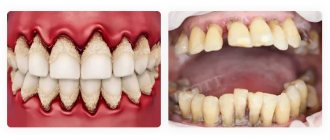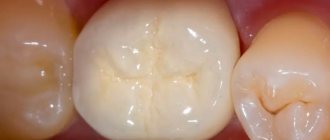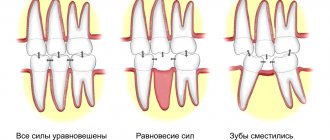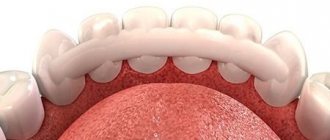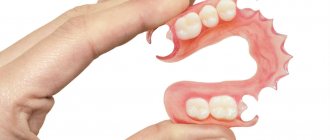How to use prosthetic teeth for periodontitis and periodontal disease
Periodontitis and periodontal disease are gum diseases with different origins. The first pathology occurs due to pathogenic microorganisms, and the cause of the second is a metabolic disorder in tissues. The processes in both cases lead to loose teeth, so it is much more difficult to prosthetize teeth. However, modern dentistry can cope with such situations and return the aesthetics of a healthy smile to the patient.
Differences and characteristics of diseases
Periodontal disease occurs when there is a metabolic disorder, which leads to a failure in the process of renewal of gum tissue. This, in turn, causes loose teeth. In the early stages, the pathology is almost impossible to detect, since there is no pain or bleeding. Other signs include:
- bad breath is noticeable;
- gums become pale;
- the roots of the teeth are exposed.
Important: without treatment, the patient may completely lose teeth.
Periodontitis is different in that it is caused by gum inflammation and in most cases it is a consequence of bacterial gingivitis. The disease has characteristic symptoms:
- swelling and severe pain;
- bad breath;
- redness of the gums.
The acute form is manifested by bleeding and constant pain. Without treatment, gum tissue erodes and cannot hold teeth in place. These pathologies have several treatment options, which are prescribed by the dentist. Advanced stages definitely require one of the prosthetic methods.
Classification and symptoms of generalized periodontitis
If you take into account the depth of the pockets and the severity of bone tissue destruction, the doctor can diagnose three forms of manifestation of the disease. They differ in symptoms and signs.
Mild periodontitis
This stage is characterized by a slight sensation of itching and burning. Bleeding periodically occurs during brushing your teeth and after eating (hard foods - meat, fresh fruits and vegetables). The depth of periodontal pockets reaches 3.5 mm, and a decrease in gum tissue is observed at approximately 1/3 of the height of the root. Pathology may not manifest itself for a long time. Therefore, at the first stage of the disease, patients are in no hurry to contact doctors, which provokes the transition of the disease to more severe forms.
Average degree of periodontitis
During its course, various pathological changes occur in the patient. In particular, the functions of the dental system change. The pocket reaches a depth of 5 mm, the teeth become mobile and slightly loose. Gaps appear between them. The tissue structure of the hole is reduced by half the root. There may be an unpleasant odor coming from your mouth.
Severe periodontitis
This disease is typical for adult patients. The depth of the periodontal pockets exceeds 5 mm, the loss in tissue is more than ½ the length of the tooth root. The gums are subject to severe inflammation and bleed. They come out with purulent discharge. Not only tissue elements are destroyed, but also bone parts. Sometimes the walls between the teeth completely dissolve, leading to severe tooth mobility. In this case, it is almost impossible to preserve them in their natural form.
The more advanced the disease, the more difficult it is to cope with it and choose adequate treatment. And the chances of a full recovery decrease with each step of its progression.
How to choose a denture for periodontal disease
The disease cannot be completely cured at the moment, but medicine can achieve stable remission and a stable condition. If the disease is detected at an early stage, then therapeutic methods are used. If the condition is neglected, the teeth will need to be completely removed and replaced with dentures.
In any case, dentists carry out treatment to achieve remission of periodontal disease and stop the loss of bone tissue. Only after this, a prosthetic option is selected, using removable or non-removable orthopedic structures:
- zirconium crowns, which are placed on your own ground teeth. Usually they are placed in the smile zone;
- bridges fixed to crowns or abutment teeth. This solution is suitable only for the initial stages of pathology;
- splinting clasp dentures. This is a conditionally removable option that has minimal impact on the oral mucosa;
- implant-supported dentures (to avoid the risk of rejection, it is important to regularly treat periodontal disease).
The choice of orthopedic design depends on the clinical case and general health. If the patient still has his own teeth, the doctor will recommend a removable denture. In difficult clinical situations, two methods are suitable: installation of splinting clasps and implantation with immediate loading.
Treatment methods for generalized severe periodontitis
Chronic periodontitis, the course of which has moved to the last, most dangerous stage, requires not only careful conservative therapy, but also surgical intervention. Indeed, at this stage, tissue destruction is pronounced, and conventional antibiotics are not enough. You will need to undergo a number of procedures aimed at restoring the affected areas and replacing teeth. Depending on the overall picture, the following types of surgical interventions are prescribed:
- removal of teeth with a high degree of mobility;
- vertical dissection of the gum wall in order to scrape tissue that has undergone pathological changes;
- horizontal excision of the pocket wall together with the affected gum (if the depth of the periodontal pockets is more than 4 mm);
- flap surgery (coronal displacement, lateral, therapy, transplantation, etc.);
- abscess incisions;
- plastic surgery in the frenulum of the tongue, lips.
An important role in the treatment of this form of the disease is played by the use of anti-inflammatory drugs, vitamin compounds, and drugs that strengthen immune function. The prognosis of the disease at this stage is unfavorable, since exacerbation does not entail remission and lasts almost constantly. In addition to tooth loss and gum decay, there is the possibility of systemic complications.
Orthopedic systems for periodontal disease
Before selecting the optimal option, it is necessary to evaluate the supporting teeth to see whether they can withstand the chewing load. They must not be allowed to fall out or become loose after prosthetics.
Important: before taking impressions, the gums should not be inflamed due to periodontal disease, otherwise the finished prosthesis, crowns or inlays will be uncomfortable to wear. In addition, the risk of root infection will increase.
The most commonly used constructions are:
- Zirconium crowns.
For this pathology, metal ceramics are contraindicated and porcelain is not used. Therefore, the patient is offered products made from zirconium dioxide. They are more expensive than other crowns made from other materials, but are biocompatible with gum tissue and provide excellent aesthetics.
- A bridge that is used only in certain cases.
Its peculiarity is that installation requires supporting teeth, inlays or implants. The gums and other tissues experience pressure from such a prosthesis, which gradually leads to bone atrophy, so the system does not last long, about 5 years.
- Implantation, which is possible even in one stage.
Previously, it took time for artificial tooth roots to heal, and only six months later permanent crowns were fixed on them. The one-stage method involves making a small puncture into which a titanium base is inserted and the prosthesis is almost immediately put on. The method is also called momentary loading implantation.
- Clasp prosthesis.
Option suitable for periodontal disease and periodontitis. It does not have high aesthetics, but returns functionality when eating. With the help of a prosthesis, the load on the bone is distributed evenly. Abutment teeth will be required for installation.
Reasons for the development of generalized periodontitis
The precursors to the formation of the disease are some exogenous and endogenous factors. The first group is small; most of the diseases of this system are provoked precisely by the internal state of the body. All etiological factors are classified into local (plaque, tartar, problems with bite, abnormal position of teeth, strands of the mucous membrane) and general (diseases of the body - diabetes mellitus, goiter of toxic origin, excess weight, hypovitaminosis, hepatitis, gastritis, etc. ). All this one way or another affects the condition of the periodontium and leads to a deterioration in its functioning.
Microbiological studies have been able to prove the fact that the leading role in the development of this condition is given to microorganisms called Prevotella Intermedia, Bacteroides forsythus, Peptostreptococcus, etc. In order for the dental system to be protected from their influence, protection in the form of plaque is provided in the dental plaque , accumulated in the gingival sulcus, periodontal pockets, and tooth roots.
The life products of pathogenic organisms contribute to the activation of the secretion of certain substances (prostaglandins, cytokines, enzymes), which lead to the destruction of periodontal tissue structures. Factors that entail a decrease in local and general protection from the influence of pathogenic bacteria include:
- smoking,
- radiation damage,
- ignoring the rules of personal hygiene regarding the oral cavity.
The development of this condition is usually preceded by inflammation of the gingival margin, which entails disruption of the connection, destruction of the ligamentous apparatus, and resorption of the alveolar bone. These changes lead to pathological mobility of teeth, overload of their individual groups, and occlusion. In the absence of adequate therapy, this disease provokes tooth loss or removal, as well as problems with the functioning of the jaw system as a whole.
Prosthetics for periodontitis
Before choosing one of the methods, the specialist conducts training. It will be approximately the same for periodontitis and periodontal disease. The set of activities includes:
- elimination of caries;
- cleaning gum pockets and teeth from stone and plaque;
- antibacterial and physiotherapy;
- removal of loose teeth.
Until recently, many types of prosthetics had contraindications for periodontal tissue diseases. The problem is that pathologies lead to thinning of the bone and loosening of the teeth.
But now prosthetics have become possible subject to certain conditions, including:
- installation of certain types of systems;
- stabilization of the pathological process;
- use of special materials.
As with periodontal disease, bridges are used at the initial stage. To restore chewing and aesthetic functions, clasps and prosthetics on implants are more often used.
Help: there is also the option of a complete denture (densary jaw) made of acrylic or nylon, but it, like the “bridge,” is rarely used because it does not prevent bone loss.
Periodontology
Treatment of periodontal diseases is primarily based on an individual approach to each patient. This is due to the characteristics of the disease in each patient, the nature of the inflammatory process and the degree of damage to the bone and connective tissue surrounding and supporting the teeth. Treatment of periodontal diseases must be comprehensive. This means that such treatment includes not only eliminating the symptoms of the disease and normalizing the condition of periodontal tissues, but also affecting the general condition of the patient’s body.
Local treatment of periodontal diseases involves the elimination of local symptoms of the identified disease and includes such measures as removal of dental plaque, sanitation of the oral cavity, grinding of sharp edges of teeth, removal of artificial crowns with elongated edges and subsequent prosthetics, filling of teeth affected by caries, replacement of dentures with incorrect designs. In addition, local treatment of periodontal diseases includes an impact on the inflammatory process in periodontal tissues, as well as individual consultation with a specialist on daily oral hygiene.
Orthopedic treatment of periodontal diseases is recommended based on a thorough diagnosis and only after local treatment measures have been carried out. Orthopedic functional therapy techniques include selective abrasion, restorative augmentation, and temporary splinting. Temporary splints are temporary prostheses made from quick-hardening plastics or composite materials. Orthopedic treatment is quite effective in the treatment of periodontal diseases, improves blood circulation and eliminates the traumatic effect of chewing pressure.
Surgical treatment often plays a major role in the complex therapy of periodontal diseases. According to modern researchers, only surgical intervention in some cases can completely eliminate the source of inflammation in periodontal tissues and stop destruction in the alveolar bone. Methods of surgical treatment of periodontal diseases include operations to correct the vestibule of the oral cavity, curettage (curettage of the gum pocket, in which tartar is removed from the surface of the tooth and under the gums) and flap operations. Indications for surgical interventions depend on the degree of damage to bone and connective tissue, and on the depth of the periodontal pocket. Modern treatment of periodontal diseases is based on careful diagnosis and the principle of complex treatment, which combines methods of local, orthopedic and surgical therapy.
Stages of prosthetics using implants
After preparing the oral cavity, classic one-stage or basal implantation is performed. The first option involves immediate installation of an implant after tooth extraction. Then the abutment is screwed onto it and a crown or prosthesis is put on. The procedure is different in that it does not require an incision in the gum and detachment of the periosteum; a small puncture is sufficient. After six months, instead of a temporary crown, a permanent crown is fixed; during this period, the implant should take root.
If the tooth has been removed a long time ago, tissue volume is increased or the basal implantation method is used. It lies in the fact that the artificial root is not implanted in the place of the previous one, but where there is enough tissue volume, that is, in a deeper layer (basal). Likewise, it requires no incision, just one puncture. This type of prosthetics is used most often when several adjacent teeth are missing. Immediate load on the bone will improve blood supply to the tissues, which will have a beneficial effect on periodontal diseases.
